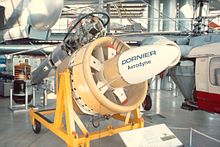Dornier Aerodyne
Under the name Aerodyne , Dornier was running an unmanned, wingless vertical take-off aircraft, designed by AM Lippisch and developed and built by Dornier on behalf of the Federal Ministry of Defense ( BMVg ). Lippisch was part of the team. The first flight took place on September 18, 1972. The development ended after successful hovering tests with the Aerodyne E1 aircraft on November 30, 1972. This experimental study was not continued because the Bundeswehr was not in need or because the intended tasks were now to be carried out with manned helicopters.
description
It was an unmanned system ( UAV ) that was supposed to carry out land- and / or ship-based flight reconnaissance as a drone .
The principle of the Aerodyne is the combination of lift and propulsion generation in one structural unit / in a flow channel, i.e. H. a ring blade with a fan. By flaps at the end of the flow channel, the air flowing through can be diverted and / or diverted as thrust, propulsion or mixed. This enabled the Aerodyne to be controlled and to fly in the entire range between hovering and maximum speed.
For forward flight, the Aerodyne had a conventional tail unit at the stern, which took over the pitch and yaw control . The device was unmanned and radio controlled .
Technical specifications
- Length: 5.5 m
- Width: 1.9 m
- Inner ring blades / fan diameter: 1.1 m
- Propulsion: 1 MTU 6022 A-3, 370 hp
- Total weight: 435 kg
swell
A documentation on the history of the Dornier company , published by Dornier GmbH, 1983, bound, 214 pages
